Effect of obesity on post-operative outcomes following colorectal cancer surgery
INTRODUCTION
Colorectal cancer (CRC) contributes substantially to the healthcare burden worldwide[1], and is the fourth most commonly diagnosed malignancy and second most common cause of cancer-related death in Australia[2]. Obesity is a rising global pandemic associated with systemic disease and poor health outcomes[3]. Body mass index (BMI) is an overall measure of total body fat, and is an easily calculable and accepted surrogate marker of obesity[4]. The World Health Organization (WHO) defines obesity in adults as a BMI of ≥ 30 kg/cm
[5].
The increasing prevalence of obesity is of particular concern to colorectal surgeons, as it is not only implicated in the pathogenesis of CRC but also may have an impact on post-operative outcomes[6].However, with several studies reporting inconsistent findings[7-9], there remains no consensus. The Clavien-Dindo Classification is a standardized system of grading post-operative complications, ranging from grade I (minor events) to grade V (death)[10]. With objective criteria, it is a highly reproducible method of grading post-operative complications, and is validated across several surgical disciplines including colorectal surgery[11].
In this study, we conducted a retrospective cohort study to outline and compare the clinical characteristics of obese and non-obese patients undergoing surgical resection of CRC at our institution, as well as to evaluate the impact of obesity on post-operative outcomes using the Clavien-Dindo Classification of Surgical Complications. The secondary aim was to determine the impact of obesity on post-operative outcomes in the subgroup of patients undergoing laparoscopic CRC resection.
MATERIALS AND METHODS
Study design
The Prince Charles Hospital (TPCH) CRC Database includes all patients who have undergone CRCresection at our institution. The criteria for inclusion in TPCH CRC Database were all patients who had histologically confirmed CRC (including appendiceal cancers as per the International Classification of Diseases-10 classification) and underwent an operation at TPCH between January 2010 and December 2020. As per the WHO definition, patients were grouped into an obese group (BMI ≥ 30) or non-obese group (BMI < 30), and the demographic features, comorbidities, and surgical features in each group were reported and compared. In addition, the post-operative outcomes of patients in each group were also compared.
Ethics approval
Approval for the TPCH Colorectal Cancer Database was granted by TPCH Human Research Ethics Committee (HREC/17/QPCH/295).
Demographics and comorbidities
Demographic data documented in this study included age, sex, BMI, smoking, and alcohol status.Patient comorbidities were categorized into cardiac, respiratory and metabolic etiologies, with specific diseases recorded in each category if present. The American Society of Anesthesiologists (ASA) grade was also recorded (Table 1).
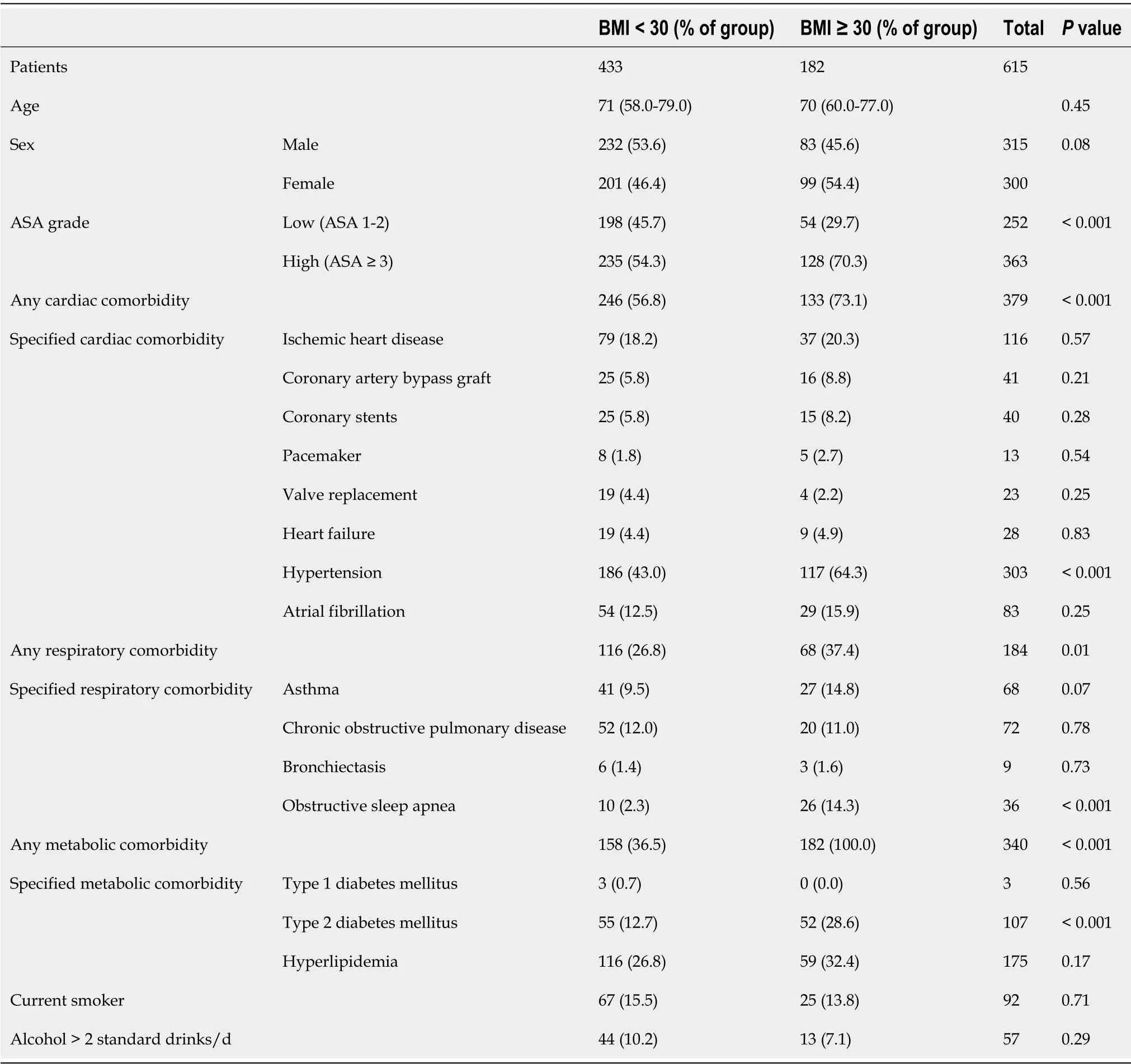

Surgical features
It is widely recognized that visceral obesity is associated with increased intra-operative technical difficulty by reducing access and visualization from thickened omentum and mesentery, distorting surgical planes, and increasing the risk of bleeding from both difficult mobilization of vessels and friable fatty tissue[20]. Our finding of poorer post-operative outcomes in obese patients undergoing laparoscopic surgery and not the obese cohort in general may be due to the fact that these aforementioned issues are aggravated in a laparoscopic approach, where increased intra-abdominal adiposity may severely restrict the already small working space available during a minimally-invasive resection. In addition, obese patients are pre-disposed to having a reduced physiologic reserve, and are thus at a greater risk of hemodynamic compromise during pneumoperitoneum from both increased intraabdominal pressure and systemic acidosis secondary to carbon dioxide absorption[21].
Post-operative outcomes
Post-operative outcomes recorded included the occurrence of any post-operative complication, which were each graded by the Clavien-Dindo Classification of Surgical Complications (Supplementary material). Complications were also classified as either no complication/low-grade and high-grade,defined as Clavien-Dindo grades I-II and III-V respectively. In addition, complications were attributed to either a surgical or medical cause, with specific surgical and medical complications also recorded if they occurred (Table 3).
The outcomes as above were also undertaken in the subgroup of patients undergoing laparoscopic surgery (Table 4). Patients who underwent laparoscopic surgery who were converted to an open procedure intra-operatively were excluded from this subgroup. Furthermore, post-operative outcomes of obese
non-obese patients were compared in subgroups divided by cancer location. Patients were divided into a right sided colon cancer (caecum to transverse colon) subgroup (Table 5), left sided colon cancer (splenic flexure to sigmoid colon) subgroup (Table 6) and a rectal cancer subgroup (Table 7).
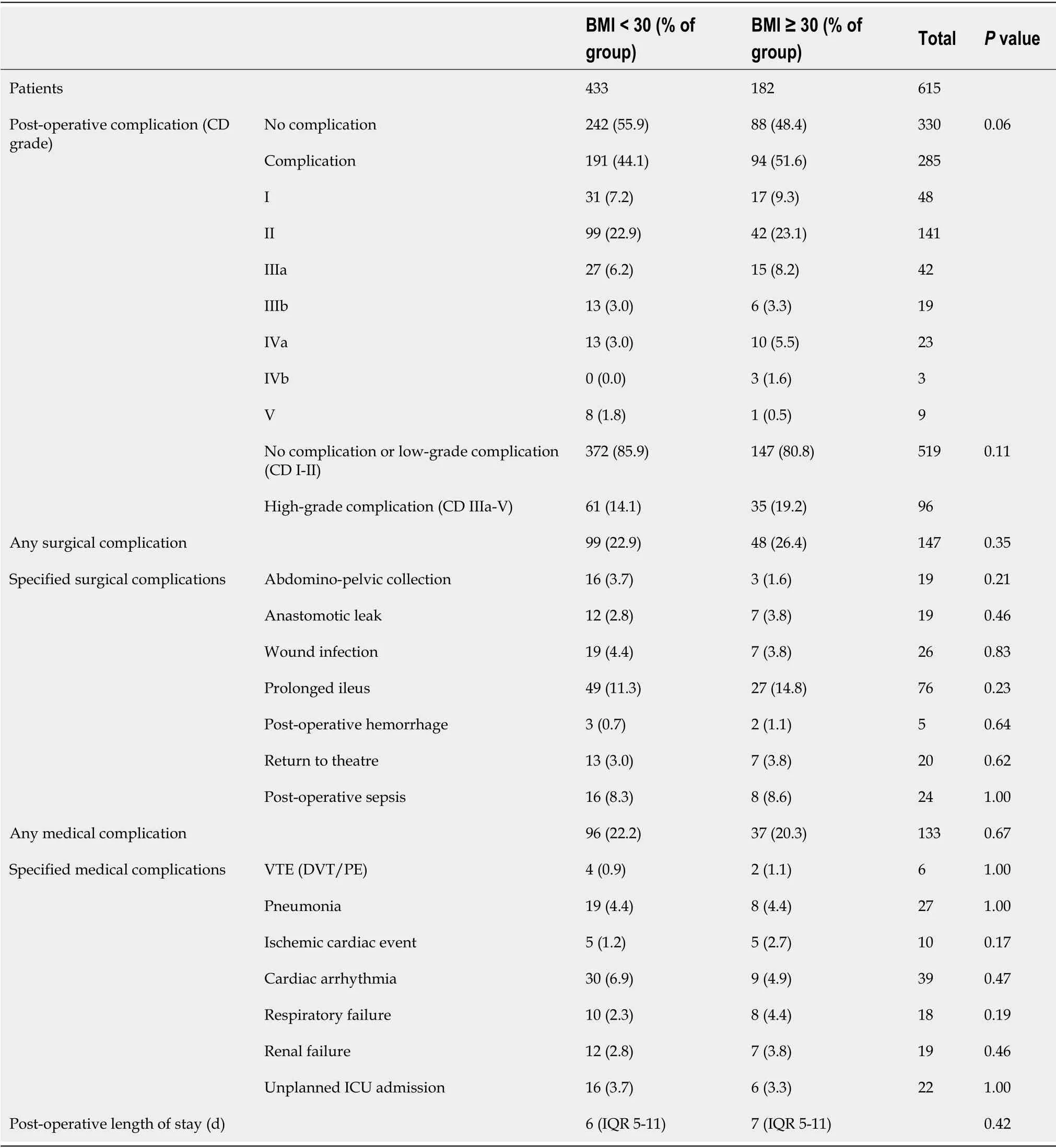
Statistical analysis
Statistical analysis was performed using Stata v17 (StataCorp, La Jolla, CA, United States). Categorial variables are presented as frequencies, and continuous variables are presented as medians and interquartile ranges. Groups were assessed using the
-test,
χ
test or Fisher’s exact test as appropriate.Statistically significant results were defined as
≤ 0.05.
RESULTS
Patient demographics and comorbidities
A total of 472 patients (76.7%) underwent laparoscopic and laparoscopic-assisted surgery; among them,336 (71.2%) had a BMI < 30, and 136 (28.8%) had a BMI ≥ 30. Obese patients in the laparoscopic surgerysubgroup similarly had a higher ASA grade (ASA I-II:36.8%
48.1%, ASA ≥ III:63.2%
51.9%;
=0.03), and a higher prevalence of pre-existing cardiac comorbidities (72.8%
56.3%;
< 0.001) and respiratory comorbidities (38.2%
26.9%;
= 0.02) compared to non-obese patients.
We recognize that as an anthropometric measure, BMI has its limitations in the ability to identify visceral obesity, and also is distributed differently among ethnic groups[26]. Our rationale for using BMI as opposed to more specific volumetric measures of intra-abdominal adiposity such as visceral fat area, is that BMI is a much more commonly used definition of obesity in the literature. This enabled us to compare our outcomes directly against a larger number of studies. In addition, given that BMI is indicative of whole-body fat, it also allows for the analysis of general adipose-associated pathophysiological processes[19].

This research has demonstrated that although obese patients were more likely to experience conversion to an open procedure (P = 0.002), they did not experience more post-operative complications (P = 0.06)or high-grade complications (P = 0.11). There were also no differences in in-hospital mortality (P = 0.06)or length of stay (P = 0.42). In the laparoscopic subgroup however, patients were more likely to experience a post-operative complication (P = 0.05), but did not experience more high-grade complications(P = 0.07).
Surgical features
Table 2 outlines and compares the surgical features between the obese and non-obese groups. Both groups had a similar proportion of elective and emergency procedures (88.5%
82.9% and 11.5%
17.1% respectively;
= 0.09). The obese group had a higher proportion of patients requiring conversion to an open procedure (12.8%
5.1%;
= 0.002). Both groups had a similar percentage of patients requiring peri-operative blood transfusion (15.4%
15.0%;
= 0.90).
Post-operative outcomes
Table 3 outlines and compares the post-operative outcomes and complications between the obese and non-obese groups. There were no significant differences between groups in terms of the prevalence ofpost-operative complications (51.6%
44.1%;
= 0.06) or high-grade complications (19.2%
14.1%;
=0.11). In-hospital mortality (Clavien-Dindo V) occurred in 1 obese patient (0.5%) and 8 non-obese patients (1.8%). There were no differences between both groups in the incidence of surgical complications (26.4%
22.9%;
= 0.35), including, but not limited to, anastomotic leak (3.8%
2.8%;
= 0.46),wound infection (3.8%
4.4%;
= 0.83) and return to theatre (3.8%
3.0%;
= 0.62). The prevalence of post-operative medical complications was also similar between both groups (20.3%
22.2%;
= 0.67),and there were no differences in the prevalence of specific medical complications. The median postoperative length of stay was also similar between both groups (7 d
6 d;
= 0.42).
The first day went really well; Kelly only fell over twice. After several days of carrying her to and from the yard, I thought, Why not encourage her to walk down the hallway a little by herself? I asked Kelly if she would like to try it, and she became very excited. The next day I sent the class out to the yard with my two assistants, and Kelly began her first journey down the hallway. She walked all the way to the next classroom, a total of ten feet. We were both thrilled! But my assistants were aghast that I was encouraging this poor child to walk. They pleaded with me to carry her outside and seat her on the bench so she could watch the other children run and play. It would be so much easier, they murmured. But Kelly was persistent10 and eager to give it her best shot.
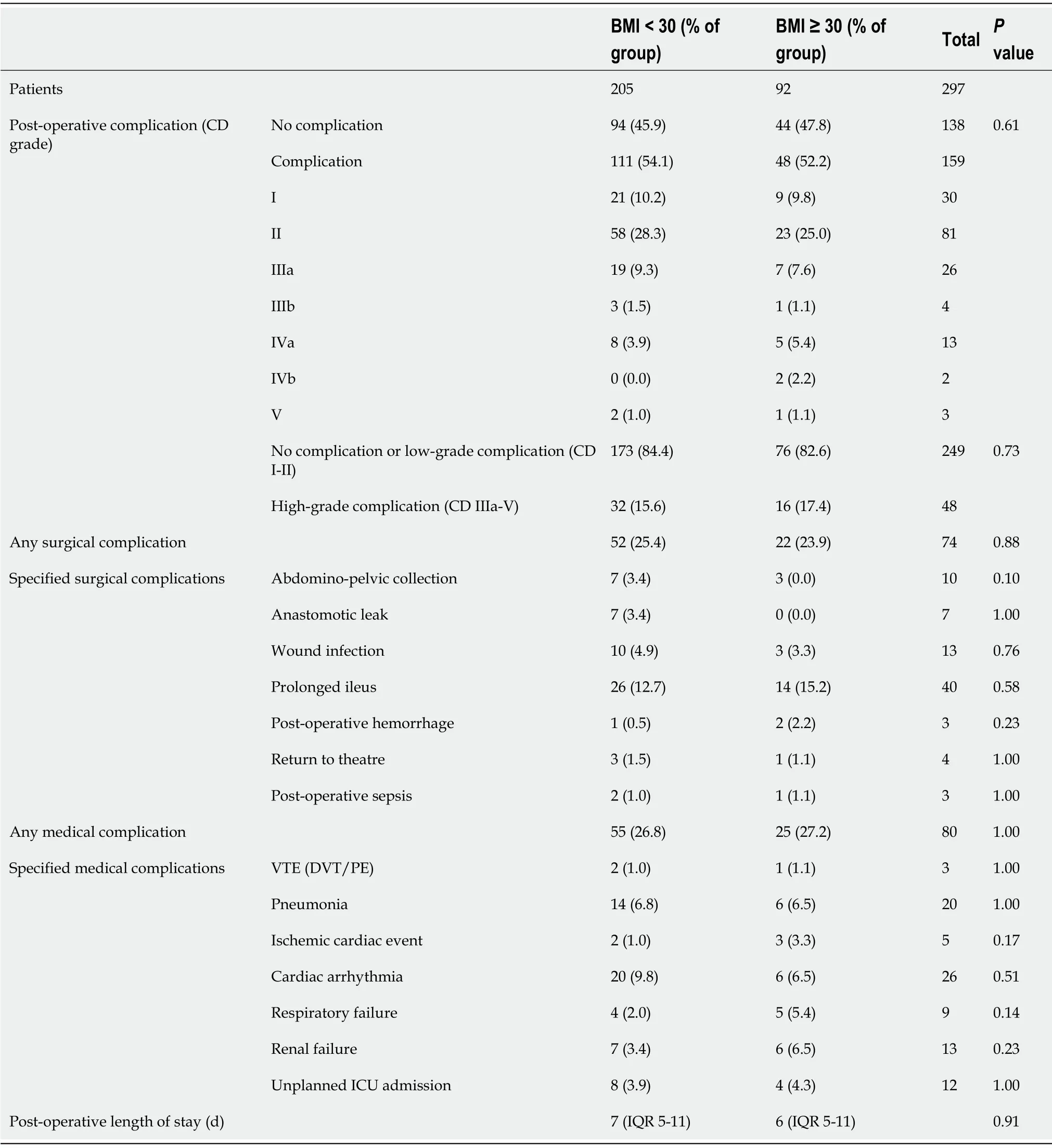
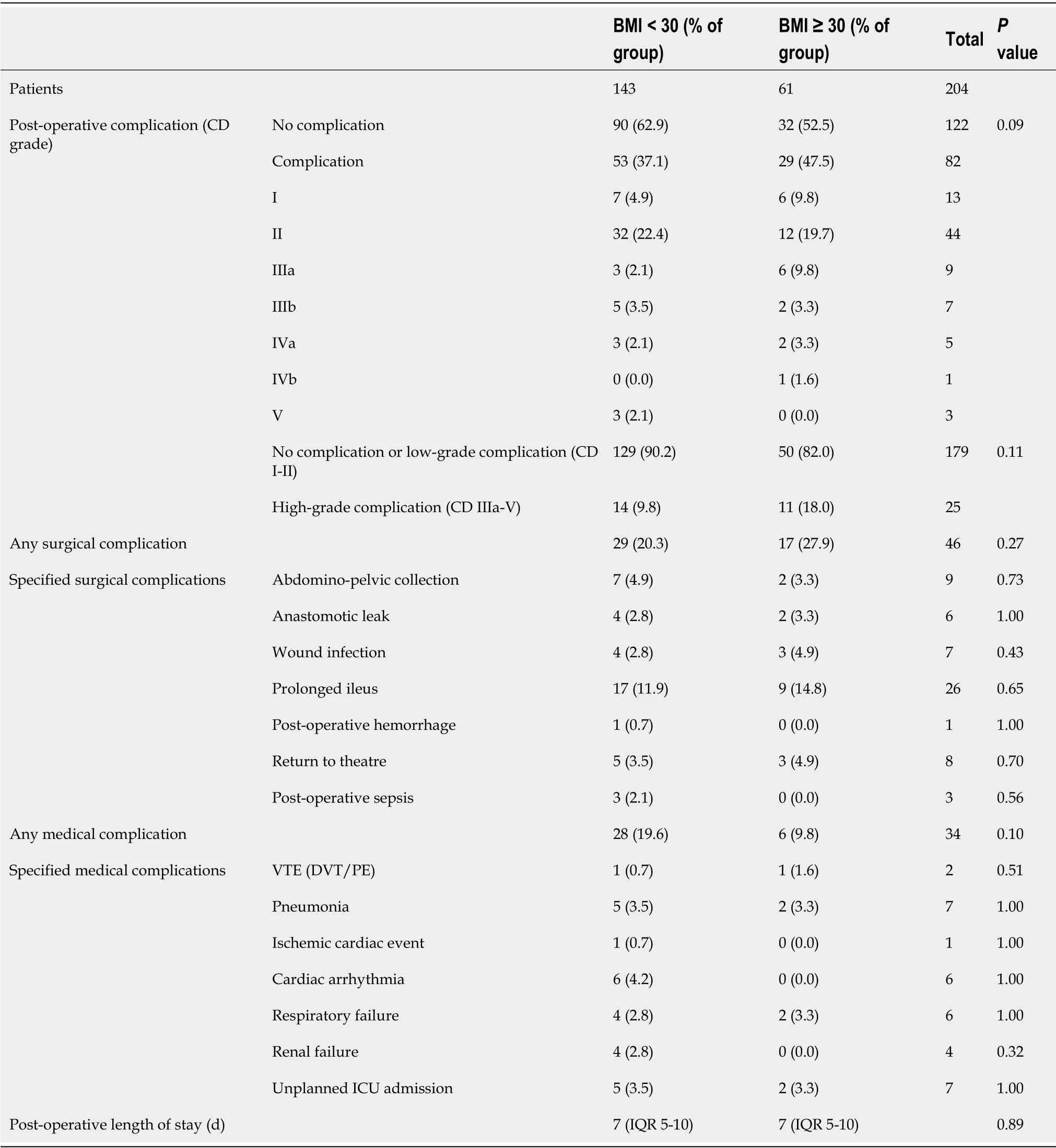
Post-operative outcomes in patients undergoing laparoscopic surgery
From January 2010 to December 2020, 615 patients at our institution fulfilled the inclusion criteria and were included in the database. In all, 182 patients (29.6%) had a BMI ≥ 30 (obese group), and 433 patients (70.4%) had a BMI < 30 (non-obese group). Table 1 outlines and compares the demographic features and comorbidities in both groups.
Upon this the three bears, seeing that some one had entered their house, and eaten up the Little, Small, Wee Bear s breakfast, began to look about them
Post-operative outcomes of the patients in the cohort undergoing laparoscopic surgery are shown in Table 4. Obese patients were more likely to experience a post-operative complication (47.8%
39.3%;
= 0.05); however, there was no differences between both groups in the incidence of high-grade complications (17.6%
11.0%;
= 0.07). There were similarly no major differences between both groups in the percentage of patients who experienced a surgical complication (27.2%
20.2%;
= 0.11) or medical complication (15.4%
19.6%;
= 0.36). The median post-operative length of stay was equivalent between both groups (6 d
6 d;
= 0.15).
In the daytime she sat down once more beneath the windows of the castle, and began to card with her golden carding-comb; and then all happened as it had happened before
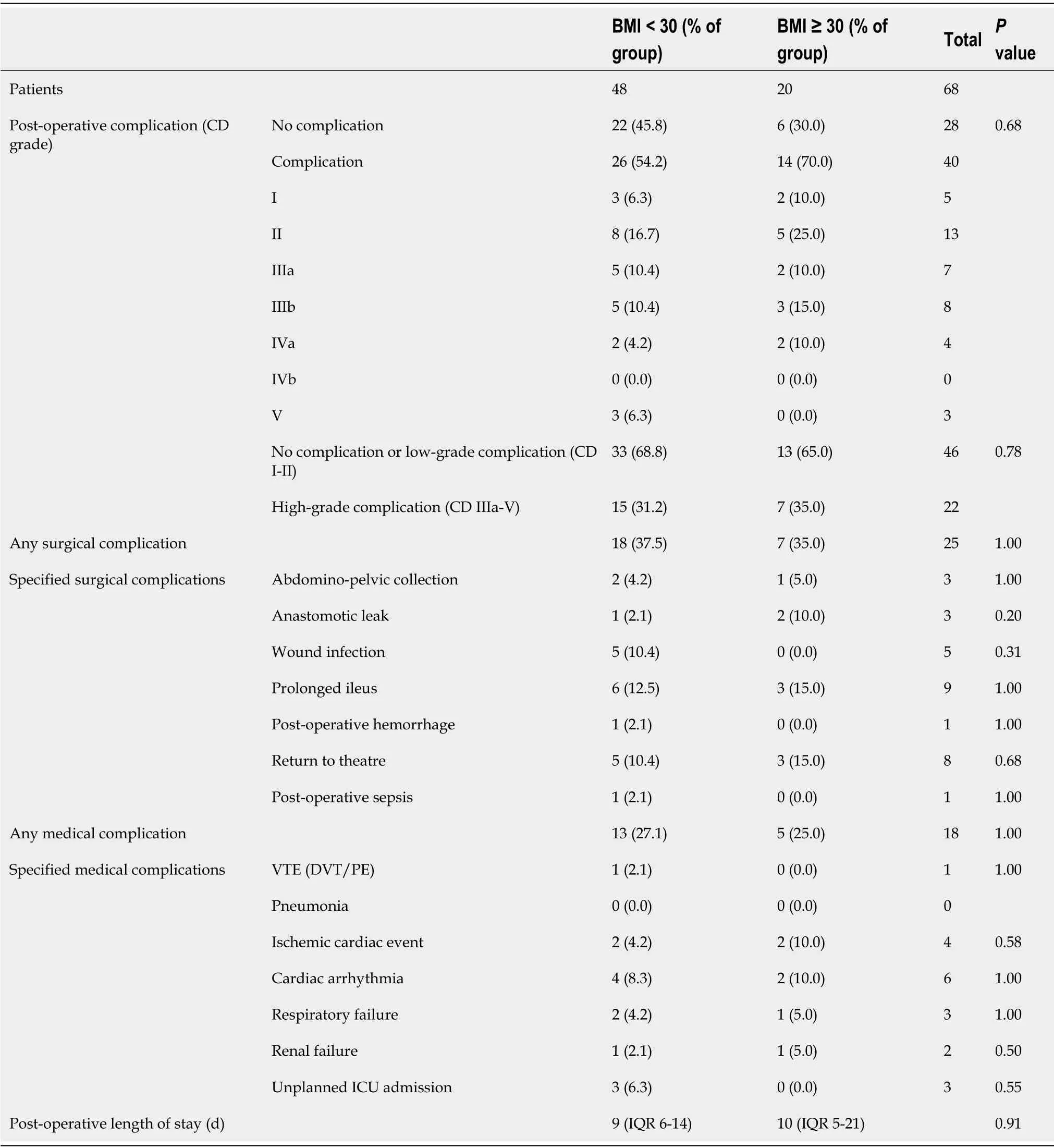
Post-operative outcomes of obese vs non-obese patients based on cancer location
Obese and non-obese patients in the right-sided colon cancer subgroup had equivalent outcomes, with no differences in the incidence of post-operative complications (52.2%
54.1%;
= 0.61), high-grade complications (17.4%
15.6%;
= 0.73), surgical complications (23.9%
25.4%;
= 0.88), or medical complications (27.2%
26.8%;
= 1.00). Similarly in the left-sided colon cancer subgroup there were no differences between obese and non-obese patients in the percentage of post-operative complications(47.5%
37.1%;
= 0.09), high-grade complications (18.0%
9.8%;
= 0.11), surgical complications(27.9%
20.3%;
= 0.27), or medical complications (9.8%
19.6%;
= 0.10). In the rectal cancer subgroup, there were also no differences between obese and non-obese patients in the prevalence of post-operative complications (70.0%
54.2%;
= 0.68), high-grade complications (35.0%
31.2%;
=0.78), surgical complications (35.0%
37.5%;
= 1.00), or medical complications (25.0%
27.1%;
=1.00).
DISCUSSION
We found that despite patients with an obese BMI having significantly higher rates of cardiac comorbidities, respiratory comorbidities, type II diabetes mellitus, and conversion to open surgery compared to patients with a non-obese BMI, there was no increased prevalence of post-operative complications (51.6%
44.1%;
= 0.06) or high-grade complications (19.2%
14.1%;
= 0.11)following CRC surgery. Our findings are concordant with Genser
[12], who reported that in patients undergoing emergency colon cancer surgery, obese patients did not experience a higher proportion of post-operative complications (54%
52%;
= 0.86) or high-grade complications (20%
17%;
= 0.47).Despite our obese cohort having a higher burden of medical comorbidities, we did not observe an increased rate of specific post-operative medical complications. Smith
[13] also showed that obese patients are not at an increased risk of post-operative pneumonia or renal failure, and Merkow
[14]showed that obese patients are similarly not at increased risk of post-operative pneumonia, cardiac arrest, myocardial infarction, or stroke. Obesity may not be an independent predictor of peri-operative cardiac complications, with the latter more accurately related to functional status rather than traditional cardiovascular risk factors[15].
Importantly, we determined that the impact of obesity on post-operative outcomes may only manifest in patients undergoing laparoscopic resection, with obese patients in this subgroup having a significantly increased prevalence of post-operative complications (47.8%
39.3%;
= 0.05). It should be noted that these findings were not influenced by patients who underwent laparoscopic converted to open surgery given that they were excluded from this subgroup.
In contrast to our findings, a Chinese study by Xia
[16] reported that following laparoscopic CRC resection, patients with a BMI ≥ 30 had a higher but non-significant incidence of Clavien-Dindo grade III complications compared to patients with a BMI of < 25 (14.3%
5.1%;
= 0.178). Similarly, a Korean study on laparoscopic CRC outcomes by Park
[17] also showed that obesity was not associated with an increased rate of major post-operative complications including ileus, bleeding and anastomotic leak(7.4%
5.3%;
= 0.889). Non-significant results in both these studies may be related to the lower prevalence of obesity in Asian countries, which is reflected by both studies having only 2.7% of their cohorts categorized as BMI ≥ 30. Two systematic reviews of laparoscopic CRC surgery outcomes in the obese by Fung
[18] and He
[19] have both reported obesity to be associated with increased overall post-operative morbidity [odds ratio (OR) = 1.54, 95% confidence interval (CI):1.21-1.97 and OR= 1.40, 95%CI:1.18-1.66 respectively].
Surgical features recorded included cancer location, operative urgency, operative approach, colorectal operation performed, requirement for stoma, and peri-operative requirement for transfusion (Table 2).
In the modern era, laparoscopic surgery has been established as the standard of care in CRC surgery[22]. Although we have shown that utilizing this approach is associated with an increased prevalence of general post-operative complications in obese patients, we acknowledge that there are circumstances where the well-recognized benefits of laparoscopic surgery such as earlier restoration of gut motility,reduced post-operative pain and shorter length of stay may outweigh the perceived risks[23,24]. Martin and Stocchi[25] have proposed several practical strategies during laparoscopic colectomy in the obese such as the use of a 30-degree laparoscope to facilitate exposure and 10 mm instruments to allow for greater leverage during retraction, as well as the use of intra-corporeal vessel ligation given potential difficulties in exteriorizing thickened omentum. Surgeons attempting a laparoscopic approach in obese patients should be adequately experienced and aware that the benefits of laparoscopic surgery likely diminish if meaningful progress in the operation is not made.
I got it. I got the joy, the sharing, the love. My dad pulled me to him in a warm embrace and just helds me for what seemed the longest time. We both cried.
We found that despite patients with an obese BMI having significantly higher rates of cardiac comorbidities, respiratory comorbidities, type II diabetes mellitus, and conversion to open surgery compared to patients with a non-obese BMI, there was no increased prevalence of post-operative complications (51.6%
44.1%;
= 0.06) or high-grade complications (19.2%
14.1%;
= 0.11)following CRC surgery.
We couldn t escape being hit, with two ME-109s firing at us point-blank. Looking out the left window, I saw the left wing covered with a sheet of flame from the cockpit to the wing tip. Frank, in the ball turret12, called on the interphone, We re on fire!
I suppose it was strange for a boy s father to wear an apron – even one with race cars – but I never thought much of it until the day that Dad broke with tradition. It was the last Sunday in August. My father seemed in an expansive(,) mood as we walked home from church together.
The dolphins sported in the waves, and the great whales spouted29 water from their nostrils30 till it seemed as if a hundred fountains were playing in every direction
CONCLUSION
Surgical resection of CRC in obese individuals is safe. A higher prevalence of post-operative complications in obese patients appears to only be in the context of laparoscopic surgery.
ARTICLE HIGHLIGHTS
Research background
Obesity is a worldwide epidemic of increasing significance. Although the colorectal surgeons of today manage a greater number of obese patients with colorectal cancer (CRC), the current literature reports inconsistent findings on whether this phenomenon impacts post-operative outcomes following CRC surgery.
Research motivation
This research was conducted to determine whether obese patients had equivalent outcomes compared to non-obese patients following CRC surgery. This is an important issue, as there is no consensus on whether obesity truly impacts post-operative outcomes, yet obese patients are at risk of having their surgery withheld or delayed based on this factor alone.
Research objectives
The primary aim of this study was to compare the post-operative outcomes of obese vs non-obese patients following CRC surgery. With laparoscopic surgery now recognized as the standard of care in CRC management, post-operative outcomes between obese and non-obese patients were also analyzed in the subgroup of patients undergoing laparoscopic CRC surgery.
Research methods
Patients who underwent CRC resection between January 2010 and December 2020 at the Prince Charles Hospital, Queensland, Australia were included in this study. As per the World Health Organization definition, this study defined obesity as a body mass index (BMI) ≥ 30 mg/kg2. Patients were divided into an obese and non-obese group, and post-operative outcomes were compared between these two groups using parametric and non-parametric tests. This study also analyzed the post-operative outcomes of obese vs non-obese patients in the subgroup undergoing laparoscopic CRC surgery.
Tsarevitch Ivan seated himself on the back of the Wolf joyfully26 enough. Take me, Gray Wolf, he said, to the Fire Bird that stole my father s golden apples, and instantly the Wolf sped away, twenty times swifter than the swiftest horse. In the middle of the night he stopped at a stone wall.
Research results
Patients in both groups were of similar age (obese group, 70 years
non-obese group, 71 years;
=0.45) and sex (45.6% male
53.6% male;
= 0.08). By contrast, the obese group had a greater proportion of patients graded at a higher ASA grade (ASA I-II:29.7%
45.7%, ASA ≥ III:70.3%
54.3%;
<0.001), and also had a higher prevalence of cardiac comorbidities (73.1%
56.8%;
< 0.001) and respiratory comorbidities (37.4%
26.8%;
= 0.01) compared to patients in the non-obese group. Obesepatients were more likely to have type II diabetes mellitus (28.6%
12.7%;
< 0.001).
Research conclusions
Our study has determined that obesity is no barrier to adequate post-operative outcomes following CRC surgery, with obese patients having equivalent post-operative outcomes compared to their non-obese counterparts. Caution is advised however, when attempting a laparoscopic approach in obese patients.
Research perspectives
Ethics approval for this database was granted by the Prince Charles Hospital Human Research Ethics Committee (Approval No. HREC/17/QPCH/295).
Not long after, the king of the country suffered from thedeepest melancholy17. He was diligent18 and industrious19, but employmentdid him no good. They read deep and learned books to him, and then the lightest and most trifling20 that could be found, but all to no purpose.
Mao D designed the study, performed the research, and wrote the manuscript; Flynn DE designed the study methodology and helped perform the research; Yerkovich S helped with data collection,statistical analysis, and manuscript review; Tran K and Gurunathan U helped with data collection, clinical advice,data analysis, and manuscript review; Chandrasegaram MD helped with design methodology and conceptualization,study supervision, manuscript editing and finalization.
Although BMI is a well-recognized and accepted surrogate marker of obesity, further studies in this area should analyze post-operative outcomes using other markers of visceral obesity. In addition, the effect of nutritional status and body composition on post-operative outcomes can be explored.
Your grandchild, Little Red Riding Hood, replied the wolf, counterfeiting4 her voice; who has brought you a cake and a little pot of butter sent you by mother.
I certify that patients were not required to give informed consent to the study because the analysis used anonymous clinical data that was obtained after each patient agreed to treatment by written consent.
All the authors report no relevant conflicts of interest for this article.
No additional data are available.
This article is an open-access article that was selected by an in-house editor and fully peer-reviewed by external reviewers. It is distributed in accordance with the Creative Commons Attribution NonCommercial (CC BYNC 4.0) license, which permits others to distribute, remix, adapt, build upon this work non-commercially, and license their derivative works on different terms, provided the original work is properly cited and the use is noncommercial. See:https://creativecommons.org/Licenses/by-nc/4.0/
Australia
The prince, however, replied that he was there for one thing only; that his first duty was to beat the drums and announce himself as a suitor, when he would be taken, as such, to the king, who would then give him proper lodgment
Derek Mao 0000-0002-3979-734X; David E Flynn 0000-0003-2150-3849; Stephanie Yerkovich 0000-0003-4163-4782; Kayla Tran 0000-0002-9216-6774; Usha Gurunathan 0000-0002-0336-872X; Manju D Chandrasegaram 0000-0002-4826-5038.
Wang JJ
But life did not depart from him- the thread would not break,but the thread of memory was severed; the thread of his mind hadbeen cut through, and what was still more grievous, a body remained- a living healthy body that wandered about like a troubled spirit.
Filipodia
Wang JJ
1 Ferlay J, Soerjomataram I, Dikshit R, Eser S, Mathers C, Rebelo M, Parkin DM, Forman D, Bray F. Cancer incidence and mortality worldwide:sources, methods and major patterns in GLOBOCAN 2012.
2015; 136:E359-E386[PMID:25220842 DOI:10.1002/ijc.29210]
2 Australian Institute of Health and Welfare. Cancer data in Australia. [cited 15 May 2021]. Available from:https://www.aihw.gov.au/reports/cancer/cancer-data-in-australia
3 Pi-Sunyer X. The medical risks of obesity.
2009; 121:21-33 [PMID:19940414 DOI:10.3810/pgm.2009.11.2074]
4 Borruel S, Moltó JF, Alpañés M, Fernández-Durán E, Álvarez-Blasco F, Luque-Ramírez M, Escobar-Morreale HF.Surrogate markers of visceral adiposity in young adults:waist circumference and body mass index are more accurate than waist hip ratio, model of adipose distribution and visceral adiposity index.
2014; 9:e114112 [PMID:25479351 DOI:10.1371/journal.pone.0114112]
5 Obesity:preventing and managing the global epidemic. Report of a WHO consultation.
2000; 894:i-xii, 1 [PMID:11234459]
6 Yehuda-Shnaidman E, Schwartz B. Mechanisms linking obesity, inflammation and altered metabolism to colon carcinogenesis.
2012; 13:1083-1095 [PMID:22937964 DOI:10.1111/j.1467-789X.2012.01024.x]
7 Govaert JA, Lijftogt N, van Dijk WA, Tseng LN, Liem RS, Tollenaar RA, Fiocco M, Wouters MW; Dutch Value Based Healthcare Study Group. Colorectal cancer surgery for obese patients:Financial and clinical outcomes of a Dutch population-based registry.
2016; 113:489-495 [PMID:26843323 DOI:10.1002/jso.24187]
8 Poelemeijer YQM, Lijftogt N, Detering R, Fiocco M, Tollenaar RAEM, Wouters MWJM. Obesity as a determinant of perioperative and postoperative outcome in patients following colorectal cancer surgery:A population-based study (2009-2016).
2018; 44:1849-1857 [PMID:29937416 DOI:10.1016/j.ejso.2018.05.027]
9 Healy LA, Ryan AM, Sutton E, Younger K, Mehigan B, Stephens R, Reynolds JV. Impact of obesity on surgical and oncological outcomes in the management of colorectal cancer.
2010; 25:1293-1299 [PMID:20563875 DOI:10.1007/s00384-010-0963-0]
10 Dindo D, Demartines N, Clavien PA. Classification of surgical complications:a new proposal with evaluation in a cohort of 6336 patients and results of a survey.
2004; 240:205-213 [PMID:15273542 DOI:10.1097/01.sla.0000133083.54934.ae]
11 Widmar M, Keskin M, Strombom PD, Gennarelli RL, Szeglin BC, Smith JJ, Nash GM, Weiser MR, Paty PB, Russell D,Garcia-Aguilar J. Evaluating the Validity of the Clavien-Dindo Classification in Colectomy Studies:A 90-Day Cost of Care Analysis.
2021; 64:1426-1434 [PMID:34623350 DOI:10.1097/DCR.0000000000001966]
12 Genser L, Manceau G, Mege D, Bridoux V, Lakkis Z, Venara A, Voron T, Bege T, Sielezneff I, Karoui M; on behalf of the AFC (French Surgical Association) Working Group. 30-Day Postoperative Morbidity of Emergency Surgery for Obstructive Right- and Left-Sided Colon Cancer in Obese Patients:A Multicenter Cohort Study of the French Surgical Association.
2020; 37:111-118 [PMID:30939470 DOI:10.1159/000497450]
13 Smith RK, Broach RB, Hedrick TL, Mahmoud NN, Paulson EC. Impact of BMI on postoperative outcomes in patients undergoing proctectomy for rectal cancer:a national surgical quality improvement program analysis.
2014; 57:687-693 [PMID:24807592 DOI:10.1097/DCR.0000000000000097]
14 Merkow RP, Bilimoria KY, McCarter MD, Bentrem DJ. Effect of body mass index on short-term outcomes after colectomy for cancer.
2009; 208:53-61 [PMID:19228503 DOI:10.1016/j.jamcollsurg.2008.08.032]
15 Fleisher LA, Fleischmann KE, Auerbach AD, Barnason SA, Beckman JA, Bozkurt B, Davila-Roman VG, Gerhard-Herman MD, Holly TA, Kane GC, Marine JE, Nelson MT, Spencer CC, Thompson A, Ting HH, Uretsky BF,Wijeysundera DN. 2014 ACC/AHA guideline on perioperative cardiovascular evaluation and management of patients undergoing noncardiac surgery:executive summary:a report of the American College of Cardiology/American Heart Association Task Force on Practice Guidelines.
2014; 130:2215-2245 [PMID:25085962 DOI:10.1161/CIR.0000000000000105]
16 Xia X, Huang C, Jiang T, Cen G, Cao J, Huang K, Qiu Z. Is laparoscopic colorectal cancer surgery associated with an increased risk in obese patients?
2014; 12:184 [PMID:24919472 DOI:10.1186/1477-7819-12-184]
17 Park JW, Lim SW, Choi HS, Jeong SY, Oh JH, Lim SB. The impact of obesity on outcomes of laparoscopic surgery for colorectal cancer in Asians.
2010; 24:1679-1685 [PMID:20039065 DOI:10.1007/s00464-009-0829-0]
18 Fung A, Trabulsi N, Morris M, Garfinkle R, Saleem A, Wexner SD, Vasilevsky CA, Boutros M. Laparoscopic colorectal cancer resections in the obese:a systematic review.
2017; 31:2072-2088 [PMID:27778169 DOI:10.1007/s00464-016-5209-y]
19 He Y, Wang J, Bian H, Deng X, Wang Z. BMI as a Predictor for Perioperative Outcome of Laparoscopic Colorectal Surgery:a Pooled Analysis of Comparative Studies.
2017; 60:433-445 [PMID:28267012 DOI:10.1097/DCR.0000000000000760]
20 Lascano CA, Kaidar-Person O, Szomstein S, Rosenthal R, Wexner SD. Challenges of laparoscopic colectomy in the obese patient:a review.
2006; 192:357-365 [PMID:16920431 DOI:10.1016/j.amjsurg.2006.04.011]
21 Nguyen NT, Wolfe BM. The physiologic effects of pneumoperitoneum in the morbidly obese.
2005; 241:219-226 [PMID:15650630 DOI:10.1097/01.sla.0000151791.93571.70]
22 Mamidanna R, Burns EM, Bottle A, Aylin P, Stonell C, Hanna GB, Faiz O. Reduced risk of medical morbidity and mortality in patients selected for laparoscopic colorectal resection in England:a population-based study.
2012;147:219-227 [PMID:22106248 DOI:10.1001/archsurg.2011.311]
23 Zhuang CL, Huang DD, Chen FF, Zhou CJ, Zheng BS, Chen BC, Shen X, Yu Z. Laparoscopic
open colorectal surgery within enhanced recovery after surgery programs:a systematic review and meta-analysis of randomized controlled trials.
2015; 29:2091-2100 [PMID:25414064 DOI:10.1007/s00464-014-3922-y]
24 Fujii S, Tsukamoto M, Fukushima Y, Shimada R, Okamoto K, Tsuchiya T, Nozawa K, Matsuda K, Hashiguchi Y.Systematic review of laparoscopic
open surgery for colorectal cancer in elderly patients.
2016; 8:573-582 [PMID:27559437 DOI:10.4251/wjgo.v8.i7.573]
25 Martin ST, Stocchi L. Laparoscopic colorectal resection in the obese patient.
2011; 24:263-273[PMID:23204942 DOI:10.1055/s-0031-1295690]
26 Tsujinaka S, Konishi F, Kawamura YJ, Saito M, Tajima N, Tanaka O, Lefor AT. Visceral obesity predicts surgical outcomes after laparoscopic colectomy for sigmoid colon cancer.
2008; 51:1757-65; discussion 1765[PMID:18600376 DOI:10.1007/s10350-008-9395-0]
 World Journal of Gastrointestinal Oncology2022年7期
World Journal of Gastrointestinal Oncology2022年7期
- World Journal of Gastrointestinal Oncology的其它文章
- Da Vinci robot-assisted pancreato-duodenectomy in a patient with situs inversus totalis:A case report and review of literature
- Correction to “Novel long non-coding RNA LINC02532 promotes gastric cancer cell proliferation, migration, and invasion in vitro”
- Primary signet-ring cell carcinoma of the extrahepatic bile duct:A case report
- Predictors for malignant potential and deep submucosal invasion in colorectal laterally spreading tumors
- Pediatric case of colonic perivascular epithelioid cell tumor complicated with intussusception and anal incarceration:A case report
- Neutrophile-to-lymphocyte, lymphocyte-to-monocyte, and platelet-tolymphocyte ratios as prognostic and response biomarkers for resectable locally advanced gastric cancer
